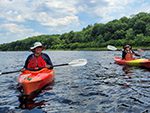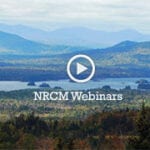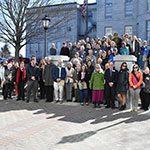NRCM works to protect Maine’s natural areas and wild, undeveloped character, particularly in the North Woods. We support responsible land development and sustainable forest practices that protect sensitive ecosystems and wildlife. We work for increased public ownership of Maine lands, so future generations will know the Maine we love today.
Protection of Maine’s natural, remote areas was one of the issues for which NRCM was founded in 1959. More than 60 years later, much progress has been made but major threats to Maine’s land and water resources continue.
With our coalition partners, NRCM has won many significant victories over the years, from helping establish the Allagash Wilderness Waterway to passage of legislation limiting irresponsible clear cuts. But the challenges of protecting Maine’s treasured wildlands and the wildlife that depend upon them have never been greater, nor the need more urgent.
We worked to establish a National Monument just east of Baxter State Park and continue our work to push for Land for Maine’s Future funding to acquire public lands, watchdog Maine’s public lands and the Allagash Wilderness Waterway, stop the ill-conceived East-West Highway from being built, weigh-in when harmful development is proposed in Maine’s North Woods, and ensure that any timber harvesting laws and policies are as protective as possible.
More than one-third of the state has changed ownership in the past 20 years. Corporations that have no stake in our local communities are buying up hundreds of thousands of acres. Slicing and dicing these natural areas can destroy the character of Maine’s North Woods forever.
This loss would affect not only the people of Maine but also our wildlife. The region is home to moose, bear, deer, and dozens of bird species—Boreal Chickadee, Spruce Grouse, Pine Grosbeak, Cape May Warbler, Yellow-bellied Flycatcher—for which the North Woods are the southernmost limit of their breeding range. Maine’s North Woods also provide many recreational opportunities for Maine people. Unchecked development threatens access to undeveloped, wild forests, lakes, and rivers for hiking, canoeing, camping, hunting and fishing.
While development pressures and the loss of public access continue to intensify, NRCM remains a voice for balancing economic development in Maine’s North Woods with conservation.
We invite you to learn more about our work to protect Maine’s North Woods and other natural areas, and to support our vital work for generations to come.

Poll Shows Maine Voters Ready for Action to Address Climate and Support LMF and National Monument
Augusta, Maine – Today, the Natural Resources Council of Maine (NRCM) released the results of a public opinion survey on the attitudes of likely Maine voters on a range of environmental and energy issues. The survey was completed in April by the Portland-based research firm Critical Insights. The results are being sent to more than Read More

The Return of Alewives to This Bangor-area Stream is an Epic Success Story
By John Holyoke, BDN Staff Bangor Daily News news story BRADLEY, Maine — The old saying about migrating fish holds that during the peak of a run, it’d be possible to walk from stream bank to stream bank on the backs of the fish, and never get your feet wet. While most of us don’t Read More

Climate Change to Have Drastic Effects on Gulf of Maine Lobster and Clam Fisheries, Studies Say
New work by academic researchers details how warming waters will drive some of the state’s key commercial species north and expose others to predators. By Kevin Miller, Staff Writer Portland Press Herald news story AUGUSTA — Two new scientific studies are highlighting the current and future impacts that rising ocean temperatures will have on lobster, Read More

Irving’s Plan for Aroostook Lakes Region Includes Commercial, Residential Development
by Staff Mainebiz news story J.D. Irving’s proposed concept plan for 51,000 acres in Aroostook County asks the Maine Land Use Planning Commission to allow new commercial and residential development around the Fish River Lakes chain, in addition to conservation plans and continued logging operations. The Bangor Daily News reported the plan for Irving’s acreage Read More

State Mulling New Camping Options at Eagle Lake, Deboullie
by Anthony Brino, BDN Staff Bangor Daily News news story ASHLAND, Maine — The Maine Bureau of Parks and Lands is hosting a public meeting in Ashland Wednesday to gather input on a proposal to add and expand campsites at public reserve lands around Eagle Lake and Deboullie Mountain. The Bureau of Parks and Lands, Read More

Athens Community School Receives NRCM Middle School Grant
Funds will be used for hands-on conservation learning. Central Maine newspapers news story Because of a grant from the Natural Resources Council of Maine, students participating in 4-H club at Athens Community School will learn about local wildlife and monitor their behavior. Middle school students, guided by their teacher Kassie Dwyer, will build wildlife houses and set Read More

Don’t Blame Land Conservation for Rising Maine Property Taxes
Reduced state aid to municipalities and schools is what’s putting the pinch on taxpayers. Portland Press Herald editorial For years, Gov. LePage has blamed schools for being unwilling to control costs. Now, he says, it was the land trusts all along. On the radio, in his recent State of the State address and in a Read More

Maine Land Trusts Say Governor Uses Bogus Data in Pitch to Tax Them
Conservation advocates call his claims misleading and say he ignores payments made to host towns in lieu of taxes. by Kevin Miller, Staff Writer Portland Press Herald news story AUGUSTA — Gov. Paul LePage is once again accusing conservation groups of “ripping off” taxpayers in Maine by not paying local taxes on vast swaths of Read More

LePage Policies, Not Land Trusts, Have Driven Up Property Taxes
Bangor Daily News editorial In Tuesday’s State of the State speech, Gov. Paul LePage highlighted a serious problem that deserves attention in Augusta and beyond. Maine’s property taxes are too high, and they are rising. LePage, however, identified the wrong source of the problem. The governor, a long-time critic of land conservation, blamed land trusts Read More
Banner photo: Moose near Baxter State Park, by Gerard Monteux










